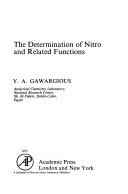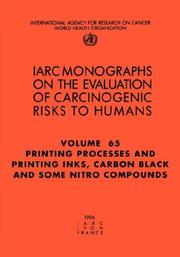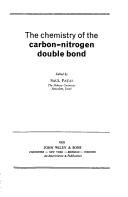| Listing 1 - 5 of 5 |
Sort by
|

ISBN: 0122779509 9780122779503 Year: 1973 Volume: 5 Publisher: London Academic press
Abstract | Keywords | Export | Availability | Bookmark
 Loading...
Loading...Choose an application
- Reference Manager
- EndNote
- RefWorks (Direct export to RefWorks)
Qualitative chemical analysis --- Descriptive organic chemistry --- Organonitrogen compounds --- Analysis --- Analysis. --- 543.8 --- -Nitrogen organic compounds --- Nitrogen compounds --- Organic compounds --- Analysis of organic substances --- -Analysis of organic substances --- 543.8 Analysis of organic substances --- -543.8 Analysis of organic substances --- Nitrogen organic compounds --- Monograph
Book
ISBN: 0124012507 9780124012509 Year: 1971 Publisher: New York (N.Y.) Academic press
Abstract | Keywords | Export | Availability | Bookmark
 Loading...
Loading...Choose an application
- Reference Manager
- EndNote
- RefWorks (Direct export to RefWorks)
Organonitrogen compounds --- Nitrogen oxides --- Heterocyclic compounds --- Oxydes d'azote --- Composés hétérocycliques --- Composés hétérocycliques --- Nitrogen organic compounds --- Nitrogen compounds --- Organic compounds --- Oxides --- Cycloids, Mixed (Chemistry) --- Heteroatomic compounds --- Heterocycles --- Mixed cycloids (Chemistry) --- Organic cyclic compounds --- Nitrogen oxides. --- Heterocyclic compounds. --- Reaction (chemistry) --- Synthesis

Abstract | Keywords | Export | Availability | Bookmark
 Loading...
Loading...Choose an application
- Reference Manager
- EndNote
- RefWorks (Direct export to RefWorks)
Carbon-black --- -Organonitrogen compounds --- -Printing industry --- -Printing ink --- -Ink --- Manufacturing industries --- Nitrogen organic compounds --- Nitrogen compounds --- Organic compounds --- Acetylene black --- Carcinogenicity --- Health aspects --- Conferences - Meetings --- -Carcinogenicity --- Organonitrogen compounds --- Printing industry --- Printing ink --- PRINTING --- INDUSTRY --- INK --- CARBON --- NITRO COMPOUNDS --- NEOPLASMS --- OCCUPATIONAL EXPOSURE --- WORLD HEALTH ORGANIZATION --- ADVERSE EFFECTS --- CHEMICALLY INDUCED

ISBN: 0471669423 9780471669425 Year: 1970 Publisher: London Interscience publ.
Abstract | Keywords | Export | Availability | Bookmark
 Loading...
Loading...Choose an application
- Reference Manager
- EndNote
- RefWorks (Direct export to RefWorks)
547.12 --- Organonitrogen compounds --- Methylenimine --- Schiff bases --- Schiff's bases --- Condensation products (Chemistry) --- Nitrogen organic compounds --- Nitrogen compounds --- Organic compounds --- Carbon bonds. Arrangement of carbon atoms in the molecule --- Methylenimine. --- Organonitrogen compounds. --- Schiff bases. --- Basic Sciences. Chemistry --- Chemistry (General) --- Chemistry (General). --- 547.12 Carbon bonds. Arrangement of carbon atoms in the molecule
Book
ISBN: 9401780641 9400763360 9400763379 Year: 2013 Publisher: Dordrecht ; New York : Springer,
Abstract | Keywords | Export | Availability | Bookmark
 Loading...
Loading...Choose an application
- Reference Manager
- EndNote
- RefWorks (Direct export to RefWorks)
This volume will present the reader with an update on the scientific research on organic chemistry of nitroso compounds that was performed in the last two decades. The overview will include the original synthetic applications of nitroso compounds, but will also cover the discovery of novel physico-chemical phenomena and their potential future uses. The properties that form the basis for this technological potential originate from the intriguing property of C-nitroso molecules to form dimers through the formation of a relatively weak nitrogen-nitrogen double bond. The equilibrium between the different monomeric and dimeric forms, which appears under controlled environmental parameters, opened new areas of research in organic chemistry. The novel paradigm presented in this volume includes insight into the original problem of organic reactivity and synthesis, but also sheds light on the solid-state reaction mechanisms. A number of fascinating photochemical, electrochemical, supramolecular, and biological properties, as well as advanced techniques in spectroscopy, now enables us to use these compounds as molecular models for studying a number of general chemical concepts. .
Medicine. --- Spectroscopy. --- Organic chemistry. --- Organometallic chemistry. --- Physical chemistry. --- Electrochemistry. --- Biomedicine. --- Biomedicine general. --- Organic Chemistry. --- Physical Chemistry. --- Spectroscopy/Spectrometry. --- Organometallic Chemistry. --- Nitroso compounds --- Organonitrogen compounds. --- Spectra. --- Nitrogen organic compounds --- Nitrogen compounds --- Organic compounds --- Chemistry, Organic. --- Chemistry, Physical organic. --- Chemistry. --- Analysis, Spectrum --- Spectra --- Spectrochemical analysis --- Spectrochemistry --- Spectroscopy --- Chemistry, Analytic --- Interferometry --- Optics --- Radiation --- Wave-motion, Theory of --- Absorption spectra --- Light --- Spectroscope --- Chemistry, Physical organic --- Chemistry, Organic --- Chemistry, Physical and theoretical --- Organic chemistry --- Chemistry --- Clinical sciences --- Medical profession --- Human biology --- Life sciences --- Medical sciences --- Pathology --- Physicians --- Physical sciences --- Qualitative --- Biomedicine, general. --- Health Workforce --- Spectrometry --- Organometallic chemistry . --- Chemistry, Organometallic --- Metallo-organic chemistry --- Chemistry, Theoretical --- Physical chemistry --- Theoretical chemistry --- Analytical chemistry
| Listing 1 - 5 of 5 |
Sort by
|

 Search
Search Feedback
Feedback About UniCat
About UniCat  Help
Help News
News